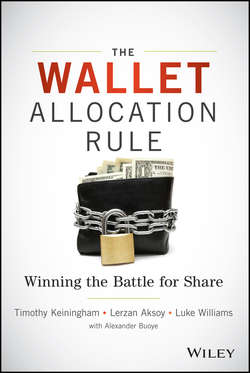Читать книгу The Wallet Allocation Rule - Aksoy Lerzan - Страница 5
На сайте Литреса книга снята с продажи.
Preface
ОглавлениеIt's never enough to tell people about some new insight…Instead of pouring knowledge into people's heads, you need to help them grind a new set of eyeglasses so they can see the world in a new way. That involves challenging the implicit assumptions that have shaped the way people have historically looked at things.1
– John Seely Brown, cochairman of the Deloitte Center for the Edge and past chief scientist for Xerox Corporation
The impetus for this book began as a quest for an answer to a problem that quite literally had shaken us to our core. We have dedicated our careers to helping companies win through improved customer loyalty. Throughout our careers, however, we consistently found that most of the things we were told about loyalty were wrong.
With each new set of myths we uncovered, we sought to set the record straight. We coauthored several books (Loyalty Myths,2 Return on Quality,3 The Customer Delight Principle,4 and Why Loyalty Matters5) and award-winning papers so that the business community could gain from our insight and avoid the pitfalls we found.
But there was one overwhelming problem that we could not explain away: The measures we use to gauge customers' perceptions of their experience (e.g., satisfaction and Net Promoter Score) are so weakly correlated to customers' share of category spending with the brands that they use that the metrics are managerially irrelevant.
This problem challenged everything we believed about customer satisfaction and loyalty. Specifically, we expect more satisfied and loyal customers to devote more of their spending to a brand. That expectation is the primary reason that efforts to improve satisfaction and loyalty are supposed to be good business decisions.
The truth was horribly bad. On average, customers' satisfaction (or Net Promoter Score) levels explain around 1 percent of the variation in customers' share of category spending. No good manager knowingly makes decisions about how to allocate a company's scarce resources based on a 1 percent model fit.
The reality, however, is that we have in effect been doing this every time we ask managers to focus on improving the customer experience to improve business outcomes. Sadly, the purportedly better-fitting models presented to managers to justify these efforts are almost always based on very bad statistics.
The result has been that businesses seldom see meaningful returns on their efforts to improve the customer experience. Not surprisingly, this has caused managers to question using these metrics to guide their businesses.
Given the seriousness of the problem, we were compelled to see if there was a better way. We began an intensive investigation to uncover why satisfaction and other commonly used metrics do not link to customers' share of spending.
The result of this investigation was the discovery of the Wallet Allocation Rule, a simple formula that managers could use to determine the share of wallet that customers allocated to their brands.
The Wallet Allocation Rule was introduced in the Harvard Business Review6 and received the Next Gen Disruptive Innovation Award.7 It has been subjected to rigorous scientific investigations.8 In addition, many of the strategies and tactics outlined in this book were introduced in the MIT Sloan Management Review.
Our goal in writing this book is to make businesses' efforts to improve customer satisfaction and loyalty pay dividends by giving them a tool that we have proved works. We believe strongly that companies that apply the Wallet Allocation Rule can distinguish themselves in the eyes of both their customers and their shareholders.
1
Brown, John Seely. “Research That Reinvents the Corporation.” Harvard Business Review 69, no. 1 (January/February 1991): 102–111. Quote on page 109.
2
Keiningham, Timothy L., Terry G. Vavra, Lerzan Aksoy, and Henri Wallard. Loyalty Myths: Hyped Strategies That Will Put You Out of Business. Hoboken, NJ: John Wiley & Sons, 2005.
3
Rust, Roland T., Anthony J. Zahorik, and Timothy L. Keiningham. Return on Quality: Measuring the Financial Impact of Your Company's Quest for Quality. Burr Ridge, IL: Irwin Professional Publishing, 1994.
4
Keiningham, Timothy L., and Terry G. Vavra. The Customer Delight Principle: Exceeding Customers' Expectations for Bottom-line Success. New York, NY: McGraw-Hill/American Marketing Association, 2001.
5
Keiningham, Timothy, Lerzan Aksoy, and Luke Williams. Why Loyalty Matters. Dallas, TX: BenBella Books, 2009.
6
Keiningham, Timothy L., Lerzan Aksoy, Alexander Buoye, and Bruce Cooil. “Customer Loyalty Isn't Enough. Grow Your Share of Wallet,” Harvard Business Review 89 (2011, October): 29–31.
7
“Ipsos Allocated Its Share at Market Research Innovation Awards,” Ipsos Press Release, November 9, 2011, accessed September 27, 2013, http://www.ipsos-na.com/news-polls/pressrelease.aspx?id=5402.
8
Examples include Aksoy, Lerzan. “Linking Satisfaction to Share of Deposits: An Application of the Wallet Allocation Rule.” International Journal of Bank Marketing 32, no. 1 (2013): 28–42; and Keiningham, Timothy L., Bruce Cooil, Edward C. Malthouse, Alexander Buoye, Lerzan Aksoy, Arne De Keyser, and Bart Larivière. “Perceptions Are Relative: An Examination of the Relationship between Relative Satisfaction Metrics and Share of Wallet.” Journal of Service Management, 26, no. 1 (2015), forthcoming.
